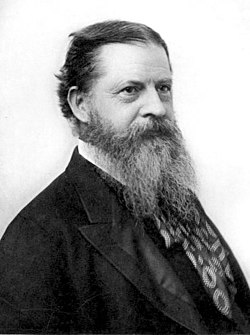
Back Teori semiotika Peirce ID チャールズ・サンダース・パースによる記号の要素とクラス Japanese İkon (göstergebilim) Turkish 皮爾士符號學理論 Chinese
This article provides insufficient context for those unfamiliar with the subject. (July 2017) |
| Part of a series on |
| Charles Sanders Peirce |
|---|
 |
| Pragmatism in epistemology |
| Logic |
| Semiotic theory |
| Miscellaneous contributions |
| Biographical |
Charles Sanders Peirce began writing on semiotics, which he also called semeiotics, meaning the philosophical study of signs, in the 1860s, around the time that he devised his system of three categories. During the 20th century, the term "semiotics" was adopted to cover all tendencies of sign researches, including Ferdinand de Saussure's semiology, which began in linguistics as a completely separate tradition.
Peirce adopted the term semiosis (or semeiosis) and defined it to mean an "action, or influence, which is, or involves, a cooperation of three subjects, such as a sign, its object, and its interpretant, this trirelative influence not being in any way resolvable into actions between pairs."[1] This specific type of triadic relation is fundamental to Peirce's understanding of logic as formal semiotic.[2] By "logic" he meant philosophical logic. He eventually divided (philosophical) logic, or formal semiotics, into (1) speculative grammar, or stechiology[3] on the elements of semiosis (sign, object, interpretant), how signs can signify and, in relation to that, what kinds of signs, objects, and interpretants there are, how signs combine, and how some signs embody or incorporate others; (2) logical critic, or logic proper, on the modes of inference; and (3) speculative rhetoric, or methodeutic, the philosophical theory of inquiry, including his form of pragmatism.
His speculative grammar, or stechiology, is this article's subject.
Peirce conceives of and discusses things like representations, interpretations, and assertions broadly and in terms of philosophical logic, rather than in terms of psychology, linguistics, or social studies. He places philosophy at a level of generality between mathematics and the special sciences of nature and mind, such that it draws principles from mathematics and supplies principles to special sciences.[4] On the one hand, his semiotic theory does not resort to special experiences or special experiments in order to settle its questions. On the other hand, he draws continually on examples from common experience, and his semiotics is not contained in a mathematical or deductive system and does not proceed chiefly by drawing necessary conclusions about purely hypothetical objects or cases. As philosophical logic, it is about the drawing of conclusions deductive, inductive, or hypothetically explanatory. Peirce's semiotics, in its classifications, its critical analysis of kinds of inference, and its theory of inquiry, is philosophical logic studied in terms of signs and their triadic relations as positive phenomena in general.
Peirce's semiotic theory is different from Saussure's conceptualization in the sense that it rejects his dualist view of the Cartesian self. He believed that semiotics is a unifying and synthesizing discipline.[5] More importantly, he included the element of "interpretant" into the fundamental understanding of the sign.[5]
- ^ 1906, EP 2:411 and CP 5.484. Peirce went on to say: "Σημείωσις [Sêmeíôsis] in Greek of the Roman period, as early as Cicero's time, if I remember rightly, meant the action of almost any kind of sign; and my definition confers on anything that so acts the title of a 'sign.'" See Σημείωσις in the Liddell & Scott Ancient Greek Lexicon at the Perseus Digital Library.
- ^ Mitchell, Jolyon; Millar, Suzanna R.; Po, Francesca; Percy, Martyn (2022). The Wiley Blackwell Companion to Religion and Peace. Hoboken, NJ: John Wiley & Sons. p. 268. ISBN 978-1-119-42441-3.
- ^ Bellucci, Francesco (2020). Charles S. Peirce. Selected Writings on Semiotics, 1894–1912. Berlin/Boston: Walter de Gruyter GmbH & Co KG. p. 10. ISBN 978-3-11-060435-1.
- ^ For Peirce's definitions of philosophy, see for instance "A Syllabus of Certain Topics of Logic", CP 1.183-186, 1903 and "Minute Logic", CP 1.239-241, 1902. See Peirce's definitions of philosophy at CDPT under "Cenoscopy" and "Philosophy".
- ^ a b Pablé, Adrian; Hutton, Christopher (2015). Signs, Meaning and Experience: Integrational Approaches to Linguistics and Semiotics (in German). Walter de Gruyter GmbH & Co KG. ISBN 978-1-5015-0231-6.